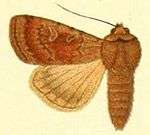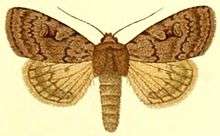Coenophila subrosea
Coenophila subrosea, the rosy marsh moth, is a moth of the family Noctuidae. The species was first described by James Francis Stephens in 1829. It is found from southern Great Britain, Italy and France, through central Europe north to Scandinavia, east to Russia, from Siberia to the Amur region, Ussuri and Sakhalin, south to northern China, east to Korea and northern Japan.

| Coenophila subrosea | |
|---|---|
 | |
| Scientific classification | |
| Kingdom: | |
| Phylum: | |
| Class: | |
| Order: | |
| Family: | |
| Genus: | |
| Species: | C. subrosea |
| Binomial name | |
| Coenophila subrosea (Stephens, 1829) | |
| Synonyms | |
| |
The wingspan is 35–41 mm.
The larvae feed on Betula nana, Myrica gale, Calluna vulgaris, Vaccinium uliginosum, Andromeda polifolia and Ledum palustre.
External links
- Kimber, Ian. "73.364 BF2115 Rosy Marsh Moth Coenophila subrosea (Stephens, 1829)". UKMoths. Retrieved 29 June 2019.
- Swedish Lepidoptera
- Lepiforum e.V.
This article is issued from Wikipedia. The text is licensed under Creative Commons - Attribution - Sharealike. Additional terms may apply for the media files.